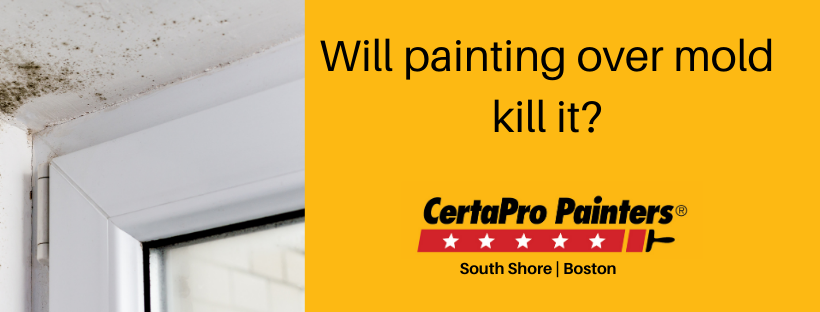
Will paint kill mold? A common question in the Boston climate.
Posted on December 9, 2020
Key takeaways from this article:
Paint and primer work to prevent mold from forming on already-clean surfaces.
Painting over mold does NOT kill it, no matter which paint or primer you use.
Mold must be removed before painting. This includes both regular and toxic black mold.
Mold-resistant paints do not reactively kill current mold but do proactively prevent mold.
Kilz brand paint does not kill mold and mildew – you need to remove the mold before painting.
If you have mold, it’s a signal that moisture is an issue – you must fix that moisture before painting, or the mold will return.
Q: What will happen if I paint over mold?
If you paint over mold, you make it impossible to see how much mold is growing behind the paint. This means toxic mold can lurk behind the paint (and keep growing) even if you can’t see it.
Q: Can you paint over mold?
A: Unfortunately, no. Some coatings claim to kill mold, but you still need to clean the mold off the surface beforehand by killing the organism and mold spores with a mold-killing detergent. It’s feasible that mold can grow underneath paint coatings and put your family’s health at risk, especially if the mold is inside your home. So, unfortunately, painting over mold does not kill it.
Q: Does primer kill mold?
No, primer needs to be applied to a mold-free surface. Some primers will prevent mold from forming but won’t kill mold that’s already there.
Q: Does Kilz kill mold?
The name “Kilz Paint” might suggest that it kills mold, but it doesn’t. It prevents mold from forming on clean surfaces.
Q: Does Kilz prevent mold from forming?
Yes, Kilz paint will prevent mold from forming as long as the area is free of mold and mildew when the Kilz paint is applied. This makes it great for damp areas where you want to prevent mold growth.
Q: What will happen if I paint over mold?
If you paint over mold, assume it is still growing behind the paint.
A few things to remember about painting if you have mold in your home:
Covering mold with paint will not kill the mold. This is true of whatever paint you use.
Mold-resistant paint only works to prevent mold, NOT reactively kill mold.
- Kilz and Zinsser make primers that claim to kill mold, but you need to remove the mold before using either of these products. Mold-inhibiting paint additives can also prevent mold from forming.
“Does Kilz kill mold?”
- Despite the brand name “Kilz,” which sounds like it would kill mold, Kilz does not kill mold but does proactively prevent it once it is applied over a mold-free surface. This makes it a good choice for damp areas.
- If you paint over mold, it will temporarily cover it, but mold will always reappear if you don’t first remediate it.
- You can add mold-inhibiting additives to paint. People tend to choose this if the “ready-made” mold-inhibiting paint doesn’t come in the colors they like, but in our experience, these additives only add a few months of “mold control” to the existing paint and aren’t worth using.
- Painting over mold can cause eventual bubbling and peeling of the paint.
- Mold and mildew indicate potential moisture problems that must be remediated before painting the surface.
- Visible mold is often the sign of mold hidden behind walls and ceilings. If you have mold in your home and you suspect is growing in places you can’t see, call a mold remediation company (not a painter or carpenter) to remove the mold professionally.
Step-by-step instructions for removing surface mold before painting:
1. Most importantly, make sure the source of the moisture is gone before painting.
This means if a leak is causing mold growth, a plumber or other professional will fix the leak before painting. If mold is in your bathroom, install a high-quality bathroom fan before repainting. You can tell you have a good fan when it can hold a 2-ply tissue when it’s running.
2. If you need to replace the drywall, now is the time to do that.
The mold deep inside the porous drywall will not be removed simply by cleaning its surface.
3. Wear proper PPE, including a face mask –
Preferably an N95 mask or full-face respirator, gloves, safety glasses, etc.
4. First, prep the wall by scraping off the peeling paint
Use a paint scraper.
5. For interiors:
Use Fiberlock Shockwave detergent according to the manufacturer’s instructions. Dip a rag in, wring it out, and use it to thoroughly clean the surface, including areas that aren’t showing visible mold (i.e., the entire ceiling, wall, or walls in the room).
For exteriors:
Liberally apply Jomax or Mold Armor brand detergents from the bottom of the surface to the top (according to the manufacturer’s instructions) using a pump sprayer. Allow it to sit on the surface for the recommended time, and then rinse it off using a hose or powerwasher.
6. Let the surface dry completely.
Don’t rush this step.
7. Prime the interior ceiling, starting with a mold-inhibiting primer such as Fiberlock brand Aftershock Primer.
You will need to prime the whole wall or ceiling, not just the part that contained the mold.
8. Paint the ceiling using a paint specifically designed for humid areas.
Sometimes called “bathroom paint” by manufacturers.
9. To prevent mold and mildew growth in the future, you may also need to install a high-strength bathroom fan:
- Buy the best one you can afford and run it regularly. Consider an “industrial” model for your home to ensure enough moisture-clearing power. A college might install these kinds of fans in a shared dorm bathroom.
- A fan with a timer is a great idea, so you aren’t running it all day if you forget to turn it off.
- Run the fan for at least 30 minutes after you turn off the shower.
- You know your bathroom fan works well when a 2-ply piece of toilet tissue is sucked against it and sticks to the fan’s vent while it is running.
- The fan must be vacuumed regularly since dust can inhibit the fan’s strength.
- If you have the choice, install the fan as close to the source of moisture as possible (for example, inside the shower stall.)
Common places for mold growth inside and outside your home:
Behind drywall, where leaks have occurred in pipes.
In high humidity rooms such as bathrooms, kitchens, laundry rooms, and basements.
In your air conditioning system or within air conditioning window units.
Inside air ducts, which subsequently spreads the mold in the blowing air.
Within rooms where the heat has been turned off.
Inside your attic, indicating a leaky roof. Mold in the attic can also occur when the bathroom fans vent to the attic space instead of the outside.
On your exterior, especially in shady areas that don’t get a lot of sunshine.
On your home’s exterior soffits and fascia – this indicates poor ventilation in the attic space.
Exterior porch ceilings when there’s inadequate ventilation in the porch area.
How do I know I have “mold-sickness?”
First of all, it’s important to know that all molds are not created equal.
The difference between “regular” mold and black mold is that black molds often cause severe health issues, while other molds may cause less severe health issues.
There are dozens of species of mold, and none of them are considered “safe” when inhaled. The health problems they cause include:
- Coughing
- Sneezing
- Fatigue
- Irritated eyes
- Headache
- Sore throat
- Those with impaired immune systems can develop serious symptoms and infections.
If you have any questions about mold and painting, please contact us at [email protected].
We’re happy to answer your questions, even if you’re doing the painting yourself.
You also might like:
Bathroom painting considerations
Photos from our recent residential projects
Photos from our recent commercial projects






